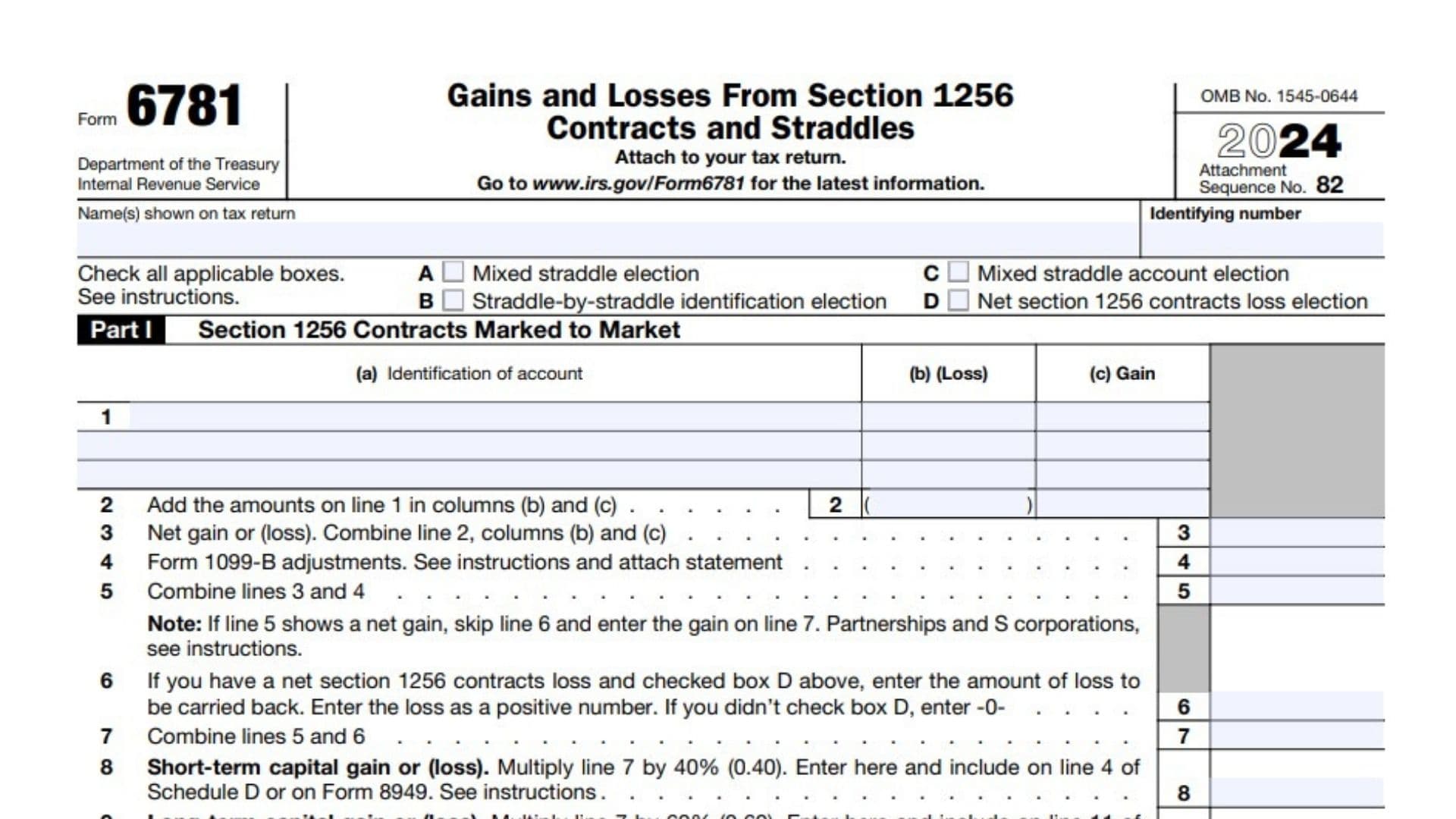IRS Form 6781, titled “Gains and Losses from Section 1256 Contracts and Straddles,” is a tax form used by investors and traders to report gains and losses from certain financial instruments, including regulated futures contracts, foreign currency contracts, non-equity options, dealer equity options, and dealer securities futures contracts. These instruments are subject to the mark-to-market rules under Section 1256 of the Internal Revenue Code, which require that they be treated as if they were sold at fair market value on the last business day of the tax year. This results in gains or losses that are split 60% long-term and 40% short-term, regardless of the actual holding period. Additionally, Form 6781 is used to report gains and losses from straddle positions, which involve holding offsetting positions to manage risk. Accurately completing this form ensures compliance with IRS regulations and proper reporting of income or losses from these complex financial instruments.
How to File Form 6781?
To file IRS Form 6781, you must attach it to your annual tax return (e.g., Form 1040) if you have reportable transactions involving Section 1256 contracts or straddles. You can download the form and its instructions from the IRS website at irs.gov/Form6781. Electronic filing is encouraged, especially for those using tax software or working with tax professionals.

How to Complete Form 6781?
Header Section:
- Name(s) shown on tax return: Enter your full legal name(s) exactly as it appears on your main tax return.
- Identifying number: Enter your Social Security Number (SSN) or Employer Identification Number (EIN), depending on your filing status.
Election Boxes (A–D):
- Box A – Mixed Straddle Election: Check this box if you have made the mixed straddle election under Section 1256(d).
- Box B – Straddle-by-Straddle Identification Election: Check this box if you have made the straddle-by-straddle identification election.
- Box C – Mixed Straddle Account Election: Check this box if you have elected to establish one or more mixed straddle accounts.
- Box D – Net Section 1256 Contracts Loss Election: Check this box if you are electing under Section 1256(d)(1) to carry back your net Section 1256 contracts loss.
Part I: Section 1256 Contracts Marked to Market
- Line 1: For each Section 1256 contract open at year-end or closed during the year, enter:
- Column (a): Description of the contract, including account identification. If reported on Form 1099-B, enter “Form 1099-B” and the broker’s name.
- Column (b): Loss realized on the contract.
- Column (c): Gain realized on the contract.
- Line 2: Total the amounts in columns (b) and (c) from Line 1 separately.
- Line 3: Combine the totals from Line 2, subtracting total losses (column (b)) from total gains (column (c)) to determine your net gain or loss.
- Line 4: Enter any adjustments related to Form 1099-B, such as those for straddle or hedging transactions. Attach a detailed statement explaining these adjustments.
- Line 5: Add Lines 3 and 4 to calculate your adjusted net gain or loss from Section 1256 contracts.
- Line 6: If you checked Box D to carry back a net Section 1256 contracts loss, enter the carryback amount here as a positive number. Otherwise, enter “0.”
- Line 7: Combine Lines 5 and 6 to determine the net amount after any carryback.
- Line 8: Multiply the amount on Line 7 by 40% (0.40). Report this short-term capital gain or loss on Schedule D or Form 8949, as applicable.
- Line 9: Multiply the amount on Line 7 by 60% (0.60). Report this long-term capital gain or loss on Schedule D or Form 8949, as applicable.
Part II: Gains and Losses From Straddles
Section A — Losses From Straddles:
- Line 10: For each loss position that is part of a straddle, enter:
- Column (a): Description of the property, including whether it is a long or short position.
- Column (b): Date the position was acquired.
- Column (c): Date the position was closed or sold.
- Column (d): Gross sales price or amount realized.
- Column (e): Cost or other basis, including any adjustments.
- Column (f): Loss realized, calculated as the amount in column (e) minus the amount in column (d). Enter “0” if there is no loss.
- Column (g): Unrecognized gain on offsetting positions.
- Column (h): Allowed loss, calculated as the amount in column (f) minus the amount in column (g). If the result is less than zero, enter “0.”
- Line 11a: Enter the total short-term portion of the losses from Line 10, column (h). Report this amount on Schedule D (Form 1040), line 4, or on Form 8949, as applicable.
- Line 11b: Enter the total long-term portion of the losses from Line 10, column (h). Report this amount on Schedule D (Form 1040), line 11, or on Form 8949, as applicable.
Section B — Gains From Straddles:
- Line 12: For each gain position that is part of a straddle, provide the following details:
- Column (a): Description of the property, specifying whether it is a long or short position.
- Column (b): Date you acquired the position.
- Column (c): Date you closed or sold the position.
- Column (d): Gross sales price or amount realized from the disposition.
- Column (e): Cost or other basis of the position, including any adjustments such as commissions and fees.
- Column (f): Realized gain, calculated by subtracting the amount in column (e) from the amount in column (d). If the result is zero or a loss, enter “0.”
- Line 13a: Enter the total short-term portion of the gains from Line 12, column (f). Report this amount on Schedule D (Form 1040), line 4, or on Form 8949, as applicable.
- Line 13b: Enter the total long-term portion of the gains from Line 12, column (f). Report this amount on Schedule D (Form 1040), line 11, or on Form 8949, as applicable.
Part III: Unrecognized Gains From Positions Held on Last Day of Tax Year
This section is for informational purposes and helps track positions with unrecognized gains as of the end of the tax year.
- Line 14: For each position held at year-end with unrecognized gains, provide the following details:
- Column (a): Description of the property.
- Column (b): Date you acquired the position.
- Column (c): Fair market value (FMV) of the position as of the last business day of the tax year.
- Column (d): Cost or other basis of the position, including any adjustments.
- Column (e): Unrecognized gain, calculated by subtracting the amount in column (d) from the amount in column (c). If the result is zero or a loss, enter “0.”
